Contents
- Optimal location for a dog kennel
- Preparation of the drawing and calculation of the dimensions of the doghouse
- We take into account all the nuances and design features of the dog house
- We prepare materials for construction
- Getting started building a house for your pet
- Some useful tips for landscaping the booth
In private estates, the dog plays the role of a yard watchman. It is instinctive for dogs to protect their territory, and the animal will cope with its work under any conditions. However, on the part of the owner, it is necessary to show respect for the pet, providing it with comfortable housing. Now we will look at how to make a booth for a dog, what calculations are needed to build a drawing, and other nuances.
Optimal location for a dog kennel
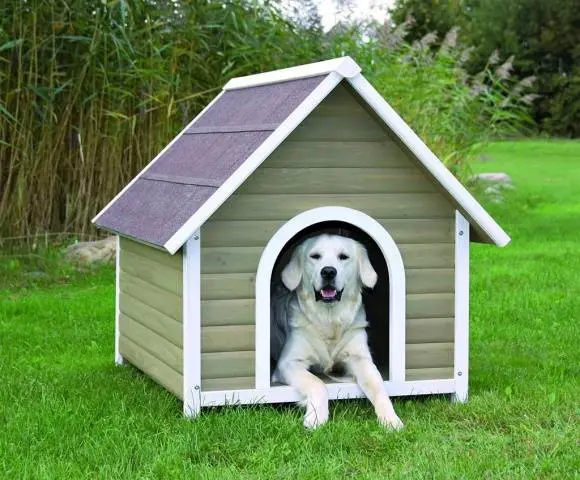
Before you make a dog house with your own hands, you need to think about where it will stand in the yard. The entire home territory should be visible to the dog, which means that the kennel will be located in a visible place. The house must be made not only comfortable for the pet, but also beautiful so that it does not spoil the aesthetics of the yard.
To ensure the most positive living conditions for the dog, a booth in the yard is located, adhering to several rules:
- The doghouse is positioned so that the wind does not blow through the hole into the house. Strong gusts accompanied by dust storms will prevent the dog from performing his duties. Here you will have to observe where the wind most often blows from, and correctly deploy the booth.
- The place should be partially illuminated by the sun and have shading. This will enable the dog to bask in the sun, and during extreme heat to hide in the shade.
- The place for the kennel is chosen taking into account the landscape of the yard. Lowlands are the worst choice for a dog house. Melt and rain water constantly accumulates here. The dog will often be wet, dirty, and mold and dampness will settle inside the house.
- Usually a dog house is installed next to the entrance to the yard and house. This allows the dog to control the most important objects, keeping strangers away from them.
Having decided on the location of the dog kennel, they begin to think about its design so that the house is most aesthetically combined with the interior of the yard.
Preparation of the drawing and calculation of the dimensions of the doghouse
The presented photo of a booth for a dog shows an example of a developed scheme for determining calculations. After all, you can’t just knock down a box, as many people think, and let the animal live there. A tight kennel will limit the movement of the dog, will not allow him to turn. Too spacious a house will be cold in winter.
To determine the optimal size of the kennel, it is necessary to measure the lying dog in length. When the dog stretches its paws forward, it is necessary to measure it with a tape measure from the claws of the paws to the edge of the tail. 15 cm are added to the stock, and the optimal width and depth of the booth are determined from the result. Why does the width have to be like this? Yes, because dogs like to sleep not only along, but also across the booth.
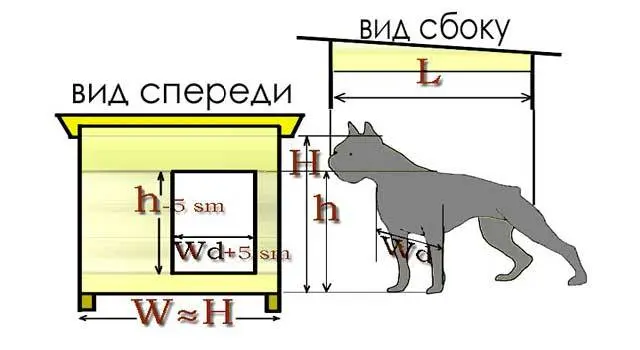
The roof of the booth for a dog with their own hands is most often made single-pitched, as the animal likes to lie on it. You can make a gable structure, but it will make the house heavier. Usually a gable roof is placed on a small kennel to increase the interior space. However, this option is only suitable for a cold booth. A ceiling is made inside the insulated house, so expanding the space due to the gable roof will not work.
In any case, the height of the dog kennel from floor to ceiling is determined by the height of the dog at the withers, adding 15 cm to the margin. The size of the hole is made 10 cm larger than the dimensions of the dog so that it can pass freely and not squeeze through a small hole. It is easier to make a hole rectangular in shape, but you can also cut an oval one with a jigsaw.
In the photo, we presented an approximate drawing of a dog house, where the dimensions are indicated. Naturally, they will have to be individually calculated for the dimensions of the dog. In addition, such a house with dimensions can be changed in the internal layout. The appearance of the structure will remain unchanged, but its dimensions will increase due to the division of the internal space by a partition into two rooms. This version of the dog kennel is considered all-weather. Another hole is cut out in the partition, through which the dog will climb into the sleeping room in winter. In summer, the dog will most often lie in the vestibule, watching everything that happens in the yard through the central hole.
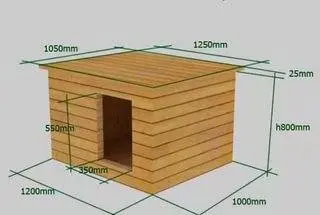
By physique, the dogs used to guard the yard can be divided into three types. This will help to calculate the size of the booth if it is not possible to measure the animal.
So, the approximate size of the house for each type of dog:
- small dogs – 70x55x60 cm;
- medium-sized dogs – 120x75x80 cm;
- large dogs – 140x100x95 cm.
The dimensions of the house are listed in order: length, width, height.
The video shows drawings of a doghouse for review:
We take into account all the nuances and design features of the dog house
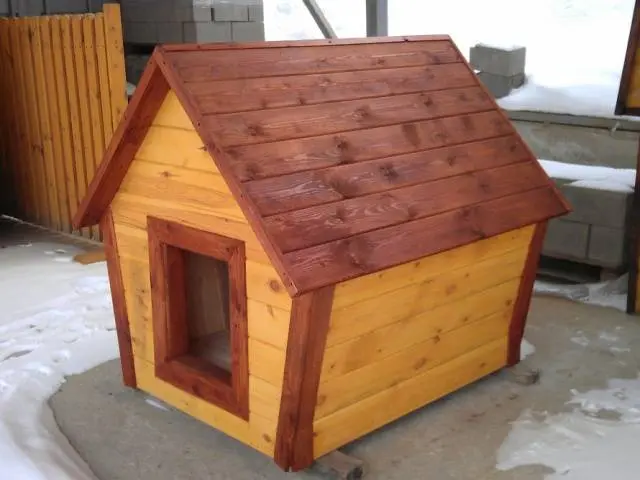
In order for the construction to be successful, do-it-yourself drawings of a booth for a dog must be correctly displayed on paper. The diagram indicates all dimensions, nodes, shapes of blanks, parameters of the roof and manhole.
During the development of the drawing, it is important to take into account the climate of the region where the animal will live. For northern regions with severe winter frosts, even a two-room booth will not be enough. Walls, floor and ceiling will have to be insulated. To do this, when drawing up the scheme, double sheathing of the frame of the dog house is provided so that a void forms between the walls. This space is filled with foam or mineral wool.
It is important to consider that many breeds of large dogs are not designed to be chained. It is impossible to leave an animal constantly walking around the yard. It is not known how the dog will behave with children or guests who have come. For large dogs, an aviary is set up in the yard, and a booth is placed inside it.
We prepare materials for construction
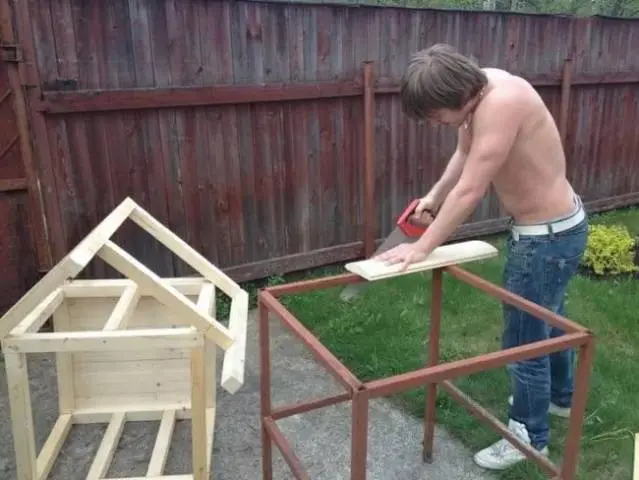
A do-it-yourself booth for a dog is made of brick, metal or wood. The first two materials do not retain heat well, do not make it possible to transfer the constructed kennel to another place and, in general, it is difficult to work with them. Wood is the best choice. You will need boards 20-30 mm thick, and a bar with a section of 50×50 mm. It is better to give preference to pine. Hardwoods will last longer, but it is very difficult to process oak or larch without a powerful power tool.
When an exact drawing of a dog house is at hand, boards and timber can be sawn to the calculated dimensions into blanks. Next, there is a difficult job of polishing wood. It is necessary to clean the blanks as much as possible from protruding knots, splinters and other flaws.
When making an insulated booth for a dog, it is immediately necessary to prepare thermal insulation. After all, it will have to be laid immediately during the sheathing of the frame. The insulation must be protected from moisture by waterproofing. In this regard, a piece of roofing material, film or other material that does not allow moisture to pass through will help.
Getting started building a house for your pet

The photo shows an option on how to build a dog house from separate elements with a gable roof. Naturally, a drawing drawn up by oneself will differ from the proposed scheme, but the main essence of the assembly of the structure is the same for any kennel.
So, holding the scheme at hand, proceed to the assembly of the house:
- The basis of the structure is the frame. It is made from timber. The first to assemble a rectangular frame of the bottom. At this stage, it is important to take into account the weight of the dog. Floors can sag under large animals. To strengthen the bottom, additional jumpers are placed on the frame.
- Four vertical posts are installed at the corners of the frame. Additional supports that form the base of the manhole are fixed in place where the front wall of the booth will be. From above, the racks of the kennel around the perimeter are fastened with a strapping of timber.
- Sheathing of the frame starts from the bottom. The floor is laid from the board, after which the booth is turned upside down. From the bottom of the frame turned out to be a cell. If the bottom of the kennel is made insulated, then a waterproofing sheet is placed in this cell, the space is filled with any insulation, and, having closed it again with waterproofing, the second bottom is stuffed from the board. The legs for the dog house can be cut from a bar or any round timber about 100 mm long. At a cold booth, the bottom from under the bottom is only upholstered with waterproofing.
- Outside, the frame of the kennel is upholstered with a board. Inside, similar cells are formed on the walls, as well as on the bottom. By the same method, insulation can be laid here. The inner lining is easier to make from the OSB board. If the booth is designed for two rooms, a partition is placed inside, and a hole is immediately cut through.
- The made main part of the booth is placed on the legs, after which they begin to fix the ceiling. In the cold version of the kennel, it is enough to nail the plywood to the upper strapping of the racks. To make an insulated ceiling, two pieces of plywood are nailed on top and bottom of the frame bars. Then a void is formed between them, which is filled with waterproofing and insulation.
- For a shed roof, a slight slope is made towards the back wall of the house. If the gable roof option is chosen, triangular rafters are knocked down from the rails and fixed to the upper frame of the kennel. A board is sewn on top, after which the roofing material is nailed. The dog will sit on a flat roof. Here it is better to make a roof of hard material so that he does not tear it with his claws. For a gable roof, even roofing material is suitable. Gables are easier to sew up with plywood.
On this do-it-yourself dog house is almost completed. Now it remains to paint and install it in its place. With the onset of cold weather, a curtain made of durable tarpaulin or rubberized fabric is nailed over the manhole.
Some useful tips for landscaping the booth
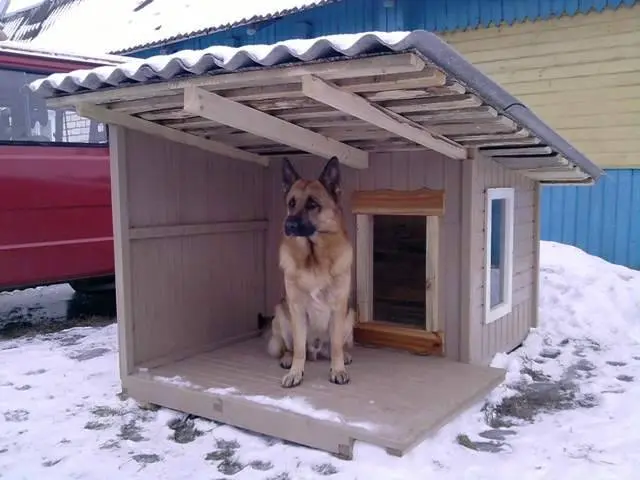
Not all dog breeds are cold tolerant. Sometimes one booth insulation is not enough. So that the dog does not freeze in winter, caring owners install electric panel heaters inside the kennel. They are produced in small sizes specifically for dog houses. As an option, even at the construction stage of the booth, an infrared film is laid under the casing, which is used for underfloor heating systems. Such heating consumes little electricity, and the pet feels comfortable even in severe frosts.
The manufacture of a dog kennel must be taken seriously. If the dog is comfortable in the house, he will thank the owner with faithful service.









